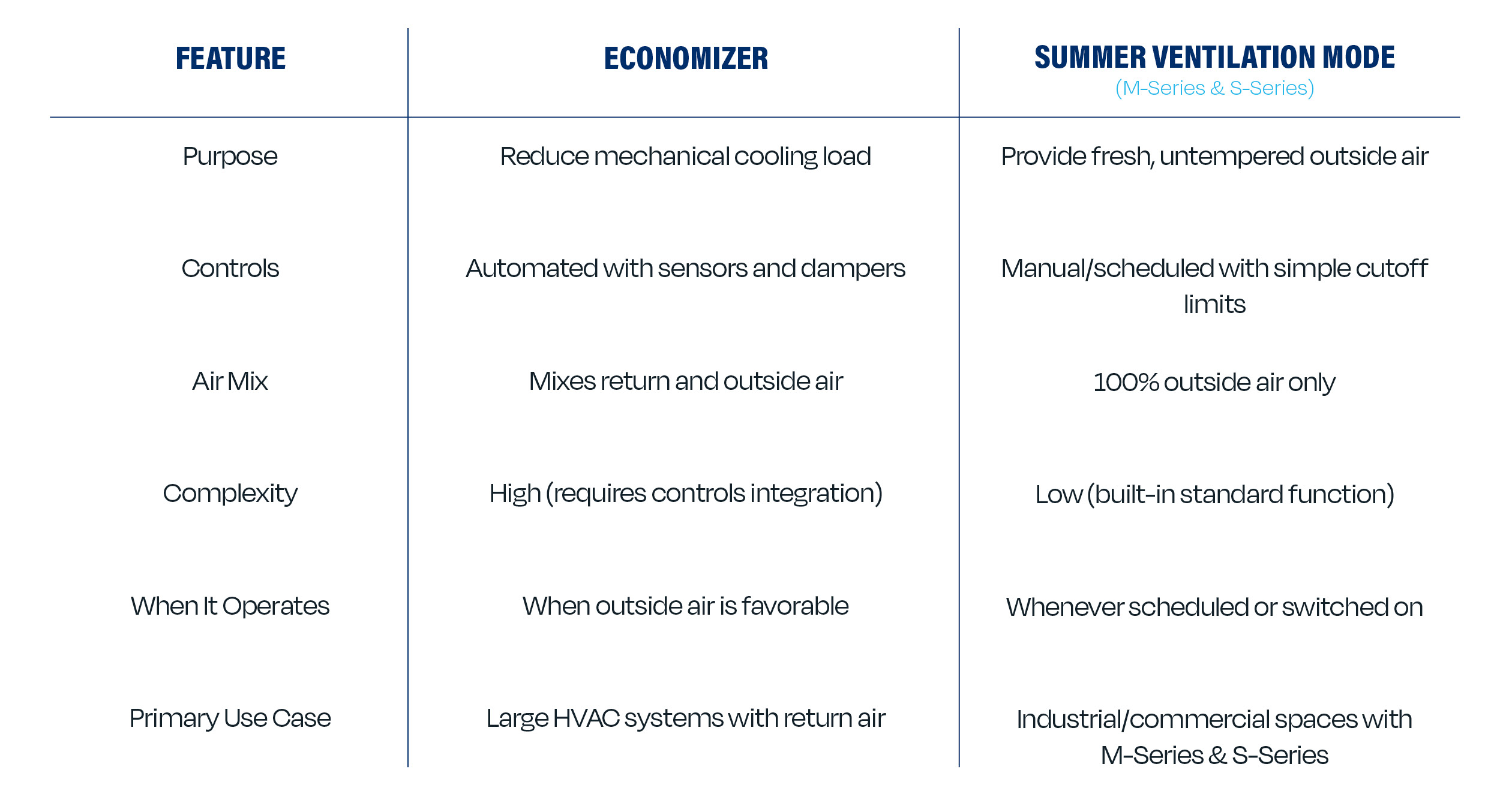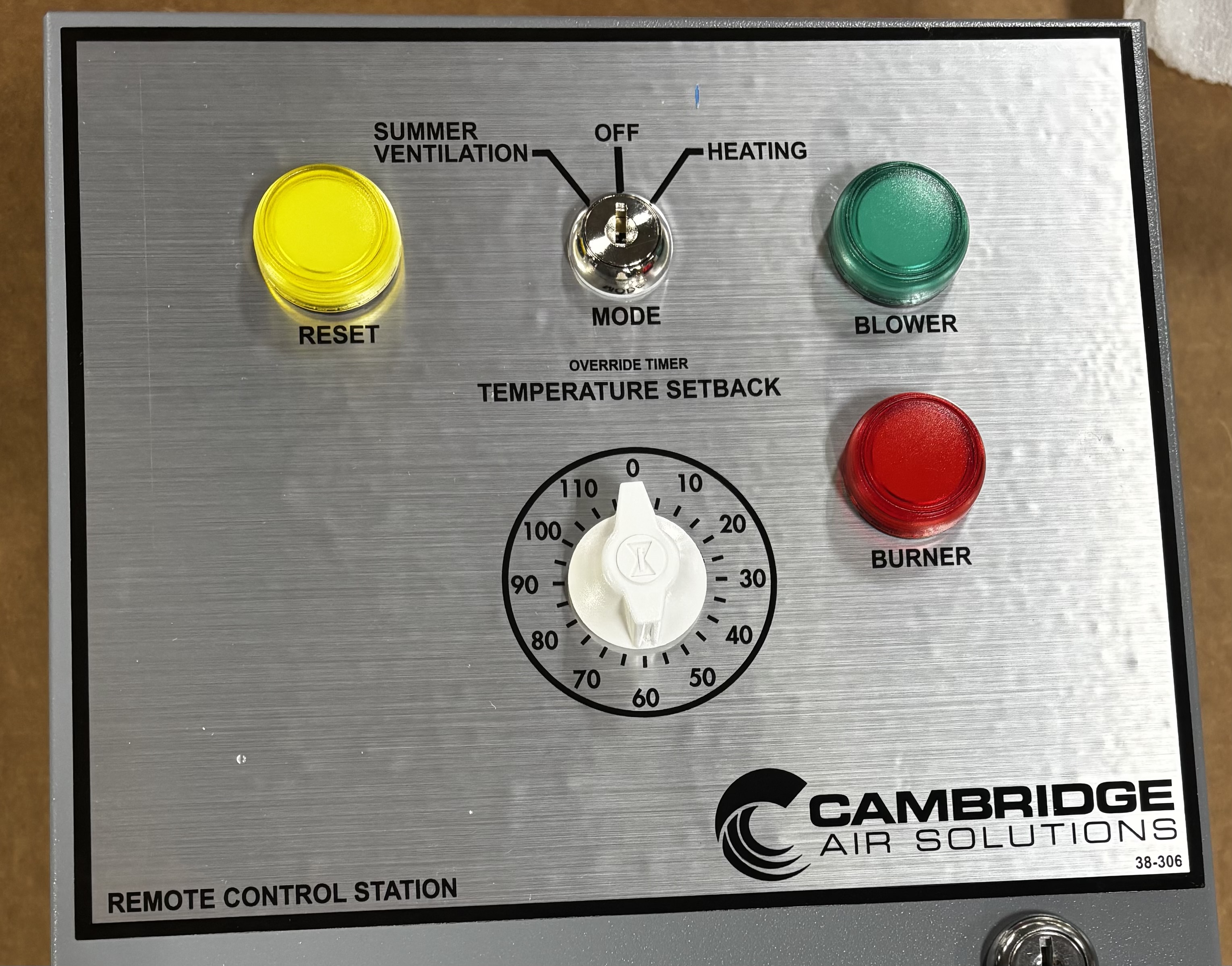When it comes to managing indoor air quality and energy use in warmer months, mechanical contractors and building owners often turn to solutions like economizers to bring in cooler outside air and reduce mechanical cooling loads. While economizers are widely used in large commercial HVAC systems, there's another approach worth understanding: summer ventilation mode.
This feature, available on certain systems like the M-Series and S-Series, introduces 100% outside air into a facility without engaging the heating burner. Summer ventilation mode offers a practical and straightforward way to support indoor comfort and system efficiency, especially when used during early morning or overnight hours. This blog aims to explain how it works, how it differs from traditional economizers, and why it may be relevant for your facility or project.
What Is an Economizer?
In HVAC systems, an economizer is a component or control system designed to reduce energy consumption by using outdoor air to cool a building when conditions are favorable.
There are two main types:
1: Dry (Air-Side) Economizer
- Uses cool outside air for “free cooling” instead of mechanically cooled air (compressor-based).
- Operates via dampers that adjust to bring in outside air and exhaust indoor air.
- Common in large commercial systems with ducted return and supply air.
2: Wet (Water-Side) Economizer
- Uses cooling towers or chilled water loops to assist in pre-cooling return air.
- More complex, typically used in data centers or large office buildings.
Economizers rely on sensors and logic controls to determine if outside air is suitable for cooling (based on temperature, humidity, enthalpy, etc.).
What is Summer Ventilation Mode on the M-Series & S-Series?
Summer ventilation mode is a feature available on certain makeup air units designed to bring in 100% outside air without engaging the unit’s burner or mechanical cooling system. It serves as a straightforward method for introducing fresh, untempered air into a space—typically during cooler times of day such as early morning or overnight.
There are two key applications:
1: Scheduled Ventilation for Temperature Relief
- Runs on a programmable schedule using a time-based controller (e.g., Temperature Setback System).
- Brings in cooler outdoor air before occupied hours to help offset rising daytime temperatures.
- Can reduce the initial demand on mechanical cooling systems when used strategically.
2: Continuous Fresh Air Supply in Ventilation-Driven Facilities
- Operates in spaces where constant airflow is required to offset process heat or meet air change requirements.
- Often used in industrial, warehouse, or manufacturing environments.
- Includes a low-temperature cutout to prevent introducing excessively cold air when outside conditions drop.
While economizers rely on sensors and damper control logic, summer ventilation mode operates through manual activation or fixed scheduling. It’s a simple approach focused on air movement and occupant comfort rather than precision cooling control.

How Summer Ventilation Mode Works 
Using the Remote Control Station (RCS), operators can activate Summer Ventilation Mode via a key switch. Once engaged, the burner is locked out and the unit operates solely as a ventilation fan, pulling in outdoor air and circulating it through the space.
To avoid introducing excessively cold air into the building, the system includes a low-temperature cutout. This safety feature allows operators to set a minimum outside air temperature (in 5-degree increments starting at 40°F). If outdoor temperatures fall below the preset limit, the unit will automatically shut off to protect indoor comfort and prevent freezing.
For added convenience and energy efficiency, Summer Ventilation Mode can also be scheduled through the unit’s Temperature Setback System (TSS). For example, facilities managers can program the unit to run from 5:00 a.m. to 7:00 a.m., allowing the building to flush out warm, stagnant air and replace it with cooler outside air before workers arrive.
Why It Matters: The Value for Contractors and Building Owners
- Reducing Cooling Load
- By bringing in cooler outdoor air during off-peak hours, Summer Ventilation Mode helps "pre-cool" the building naturally. This reduces the indoor temperature heading into the workday, minimizing how hard the mechanical cooling system has to work during the hottest part of the day. While specific energy savings will vary based on conditions, the principle is simple: starting the day cooler helps avoid steep temperature drops that require higher energy consumption.
- Improving Indoor Air Quality
- In addition to temperature benefits, Summer Ventilation Mode continuously introduces fresh air, diluting indoor contaminants, odors, and humidity levels. This is particularly valuable for industrial spaces, manufacturing facilities, and warehouses where air can become stagnant overnight.
- Flexible Operation
- Summer Ventilation Mode also provides operational flexibility. In facilities where processes create heat or exhaust fans run continuously, this mode ensures that a steady stream of outside air replenishes the space, avoiding negative building pressure while maintaining indoor comfort.
- Simple, Built-In Solution
- Unlike complex economizer systems that may require additional equipment and controls, Summer Ventilation Mode is fully integrated into the M-Series and S-Series. There are no additional components to install or configure. This simplicity can benefit contractors during design and installation and serve as a bonus for building owners seeking low-maintenance solutions.
Final Thoughts
Whether you're focused on HVAC design or long-term facility performance, understanding how summer ventilation mode works can help inform decisions. While it may not be a substitute for mechanical cooling or a full economizer setup, it can be a valuable supplemental tool, particularly in facilities with fluctuating daily temperatures or continuous ventilation needs.
Next Steps
For Mechanical Contractors: Want to explore how Summer Ventilation Mode can be integrated into your next project? Reach out to your local representative to learn more about available configurations, scheduling features, and installation support.
For Building Owners: Curious if your facility could benefit from this feature? Consider scheduling a facility assessment. Our team can evaluate your space and recommend tailored strategies to optimize comfort and energy use year-round.